
the Ostiaks, and call therisisalves by the .same name of Mansi,
The districts where they are now found reach from theVitsqhera,
on the western side, to the Khonda-and Tauda on thfje^stgr^*
They have no- community, but wandf^Jn separate families
'through the forests, and- live by hunting^, They ^till retain
much of their apeient idolatry. There ate many rivulets;.and
places in this part of Siberia, which bear the name of §§ha'i-
tanska, or Schaitanskaia, from the idols of the VpgOjufs, which
the Russians commonly, term. Schaitan. I One of- these, says„
Pallas, was lately found pear the ilfesya and the Lobva, in a
fewest newly consumed by'fire. It was a, statue ,of popper,
representing a man holding a javelin in his hand, and^stood,
near a .very lofty pine treeJ^
The'Ia’nguage of the Yogouls, according,; to., Gatterer; i -re-
semblesithe Hungarian, and the proper Finnish, and more
especially, the dialect of the Khondisb Ostiaks; Georgi, in.
his description of the nations inhabiting = the Russian empire,
derives it from the Finnish, but allows if to^have, so. n|urch
peculiarity, th a t-it may. lie considered as. a -particular language.*!*
Pallas sayS, “ Their language has.much affinity with,
the Finnish, as far as I coulcLascertain by a ypc^uljafy ;.,but
they have several dialects. The yogouls on the borders 19ft the
Sosva differ from those of the Toura, as well in their prqr
nunciation, which is shorter and more, masculine, asriij their
manner of expression. They are moreTively«.than the others’,
who are naturally phlegmatic.
Paragraph 2.—Of the Ostiaks.
The. name of the Ostiaks is very widely spread in Siberia,
and is often applied to races of men who are probably very
distinct from the proper Ostiaks of Ugrian origin, whose principal
.country is the region bordering on the Obi. The term
Ostiak appears to be derived from the Tartar Usch-st.yach,
meaning ‘foreigner’ or ‘ alien,’ and nearly synonymous in the
Turkish language with the Tschud or Tsell ud aki of the Russians.
Another origin has been ascribed to the name by Klaproth,
but this, according to Erman, is undoubtedly the true one.
-* Pallas, Voy. en Sibérïe, ibid, f Mithridates, i. p. 559. $ Pallas, vol. ili.
The tribés.of the Obi, to whom the name of Ostiak is now appro-
sp¥i^ed)lhhkhif-!l^|^^itV^lyin^3the e'astwardof the V ogouls,
and to?titexShiithward of’ the Satóóiéacs," who are their- neigh-'
bo-ur s alpl'gihe shw^siof the ïc^Séai They dwell on the borders
the-Obi'and all ütsTöbHtribrftory Stream's, from the mouth
«»■the TymMd thi'S^j^'a'bélo^^Berë^dl^'aöd^oil the shores of
jrla-e Irtish’ up.rto Baffiydkaf Klaproth "has giverf'yöcabularies
iCf vfiye "Ostiak diaiect^' Spoken' in-different dislrfct^s of the‘ Ostiak
ettehtry: they^^fenMio ihd 'Osl^alcs^bf''Bêresoyr, those
of the Tfafytti,f*thé‘ Yu^an,T^ai^pB^l, and \^ssya'gaïi.* .These
’d ia ^M p c vef^.neRt'ly allied* Other specimens Vmscollected
by Me^slïSchmidT,' and*' hiöïp rcetftyfy by ' Erman "who ‘has
added' p rey^^^ifbrfnan^i^^peb^^ this people
a’rid- their language; '* ''
^'PaliaSh^sfriade the foRo»f^óbser^'atión,s-oii--the larfgurigé
offth'd^Ostiak^.'S^^ The fahhua^#>of the t&tiaks'ori the Obf
Ms-much affinity witH'ffie 'Finni’sm êr Tschóude language, but
it KhsUStill m b ^ witH^he^Y^^m^jMany'diafedtS may'bW
rèmarkëd, diffferi^^a^drdiilg^to' the’e^Sutiy• Tft’<f|e who lives
^bftyeSÉëidzow'arid' thole Nvho borjêfër upon the'VogpuM- speak
a ver^i&iied The Morduibo," amoWp^e most disf
tatft of the Finnish dialects,i;S5that which has móst resemblance
wife tHë- Ostiak.”
It i^pidd'ènfj on an inspërifiÓfu^f^tHe'vocabularies collected
by different ‘wfitërS, that the” idiom of the Ostia ksVbeïdfiW to
the Ugrian branch of this great1 family of languages.'' It* is
.especially much nearer to-thé YpUiomian than totari^ othër
diahèt of the same class; out of Wërity-two'Vdgbuliari words
compared by Erbari, twëlyo'are iteffiediately IrebogriiSèd5 as
nearly the‘same as in the'Ostiaks There is no affihifyfeê-
tfbèri the Tartar and feè Ostiak ldnguhgeS There*is at least
not one Tartar word among tlios'e collected by Erman. O ik
the other hand, the idiom1 of theftfmatifes of Siberia display
traces of some affinity with the languages of the north-eastern
regions.' Föur of the words collected resêhïblè’the Kamtschat-
kan. Many of the1 Ostiak arid Vogómian words bear in their,
form and’construction a striking resemblance.to the languages
of the Koluschi and Aztecas in the north-western and central
y 2